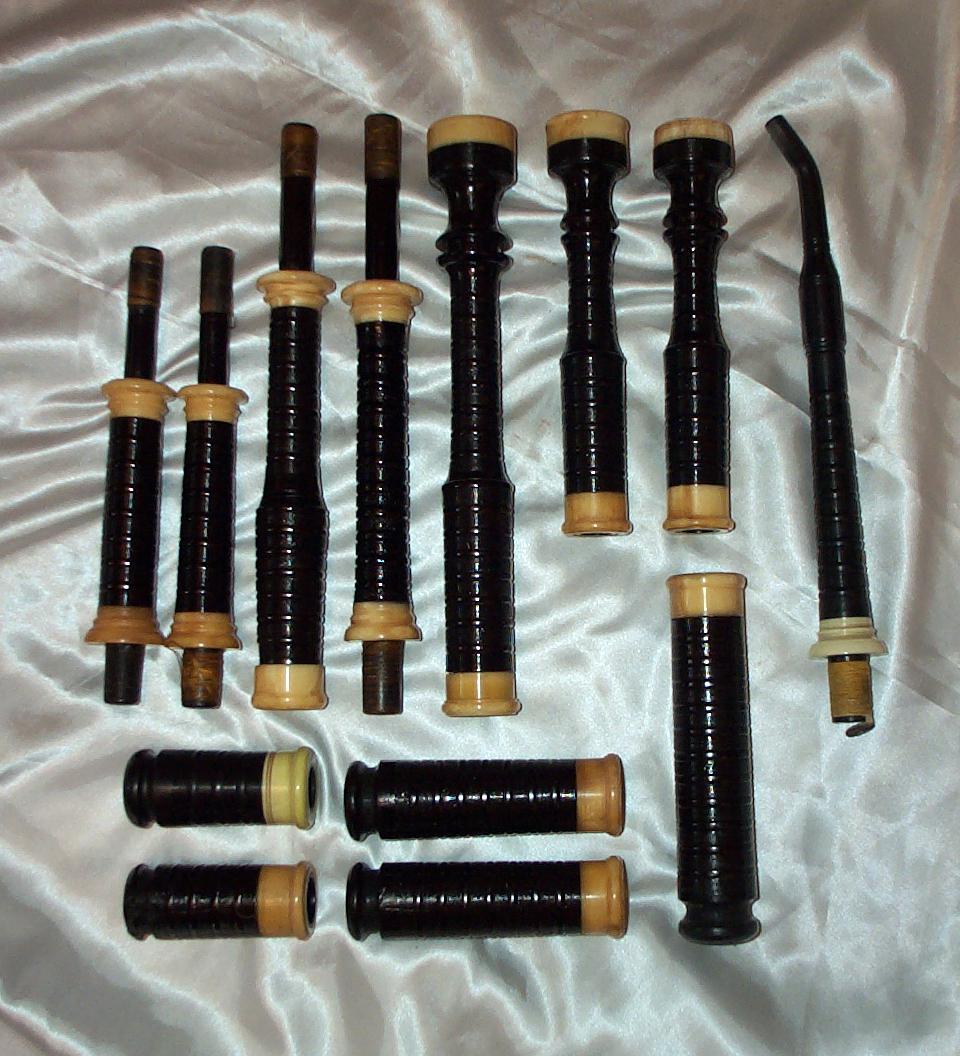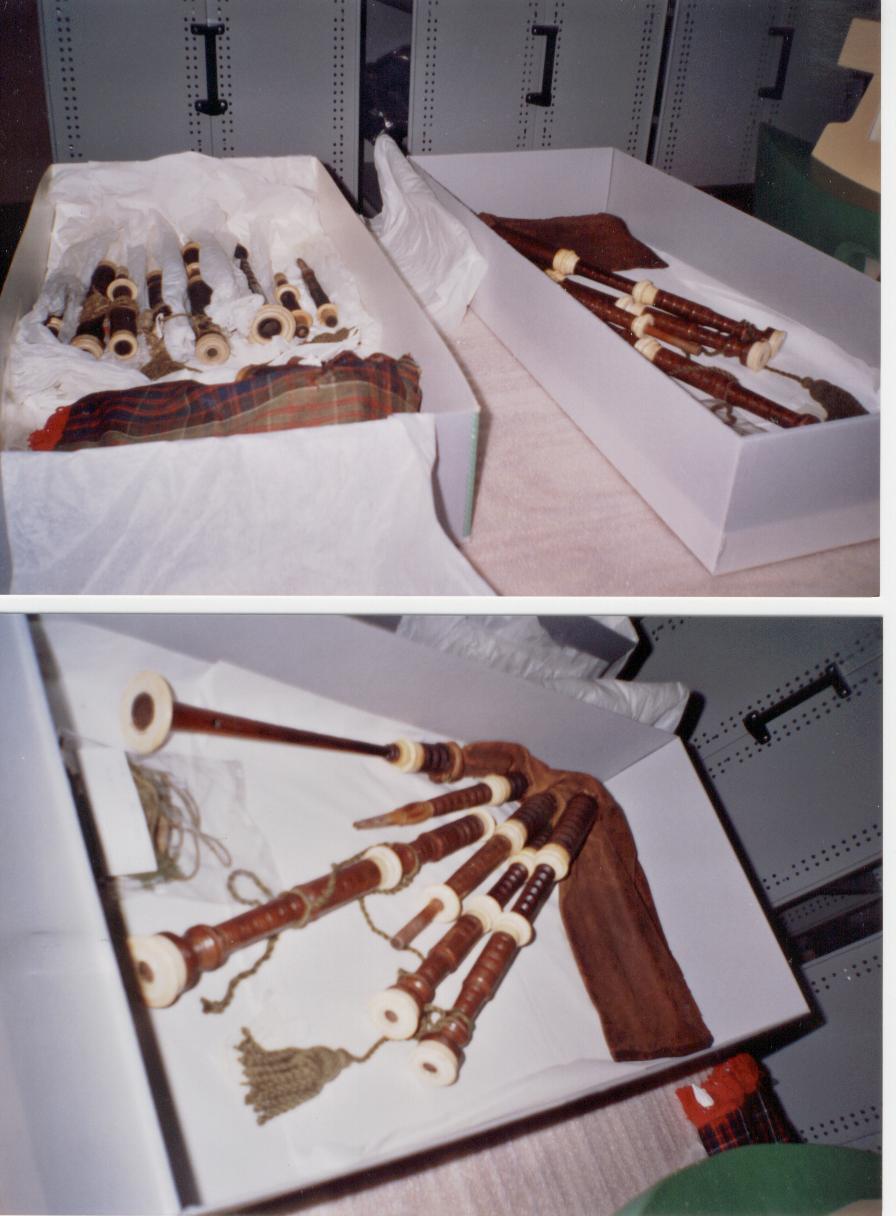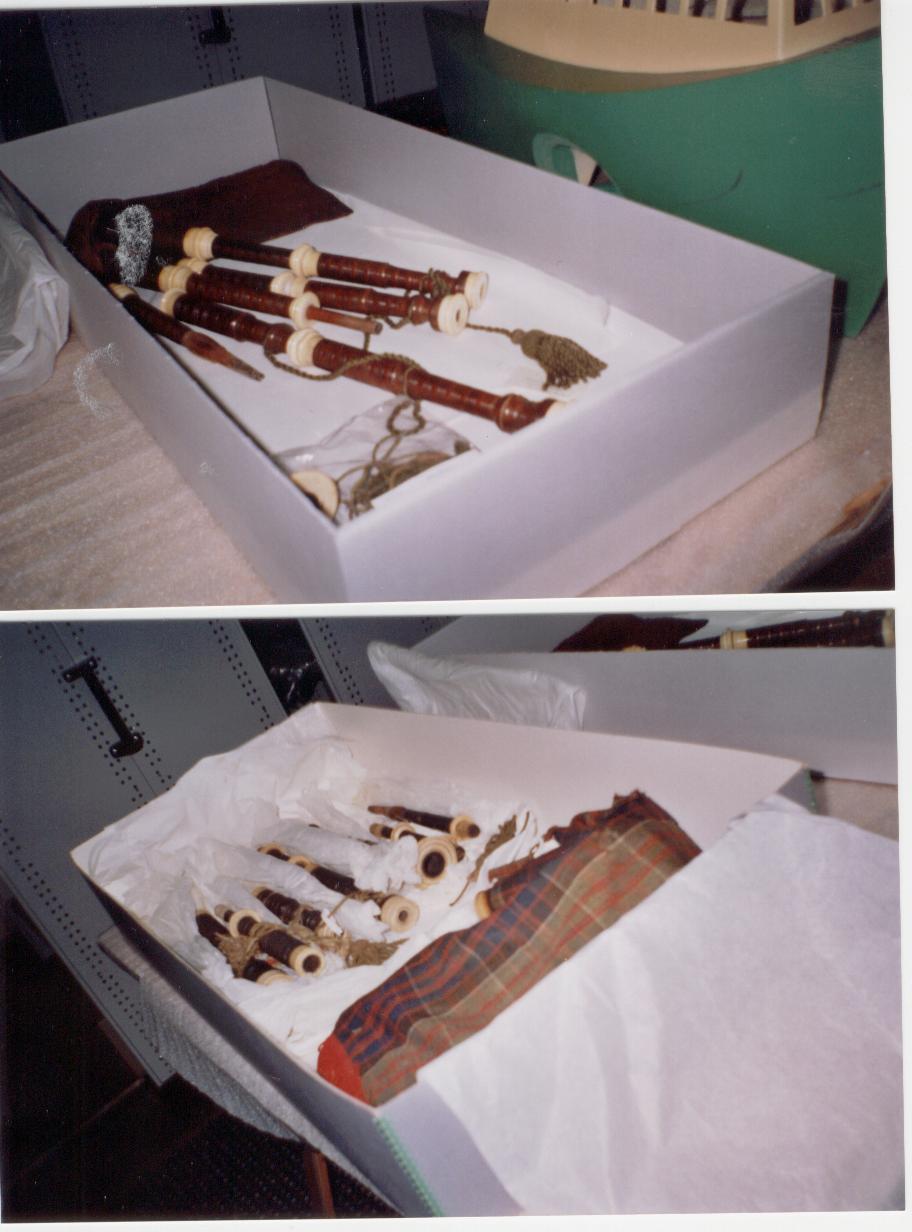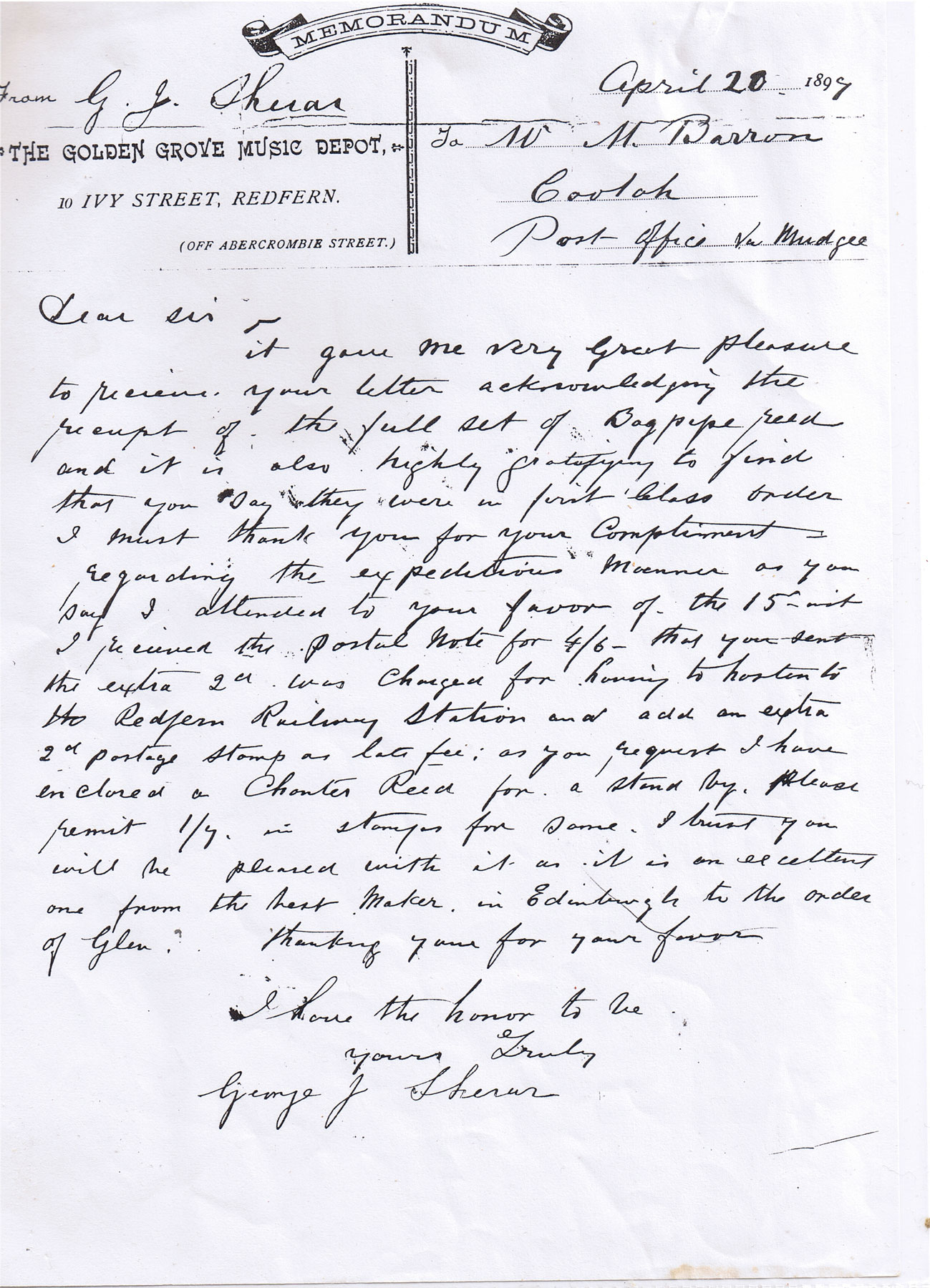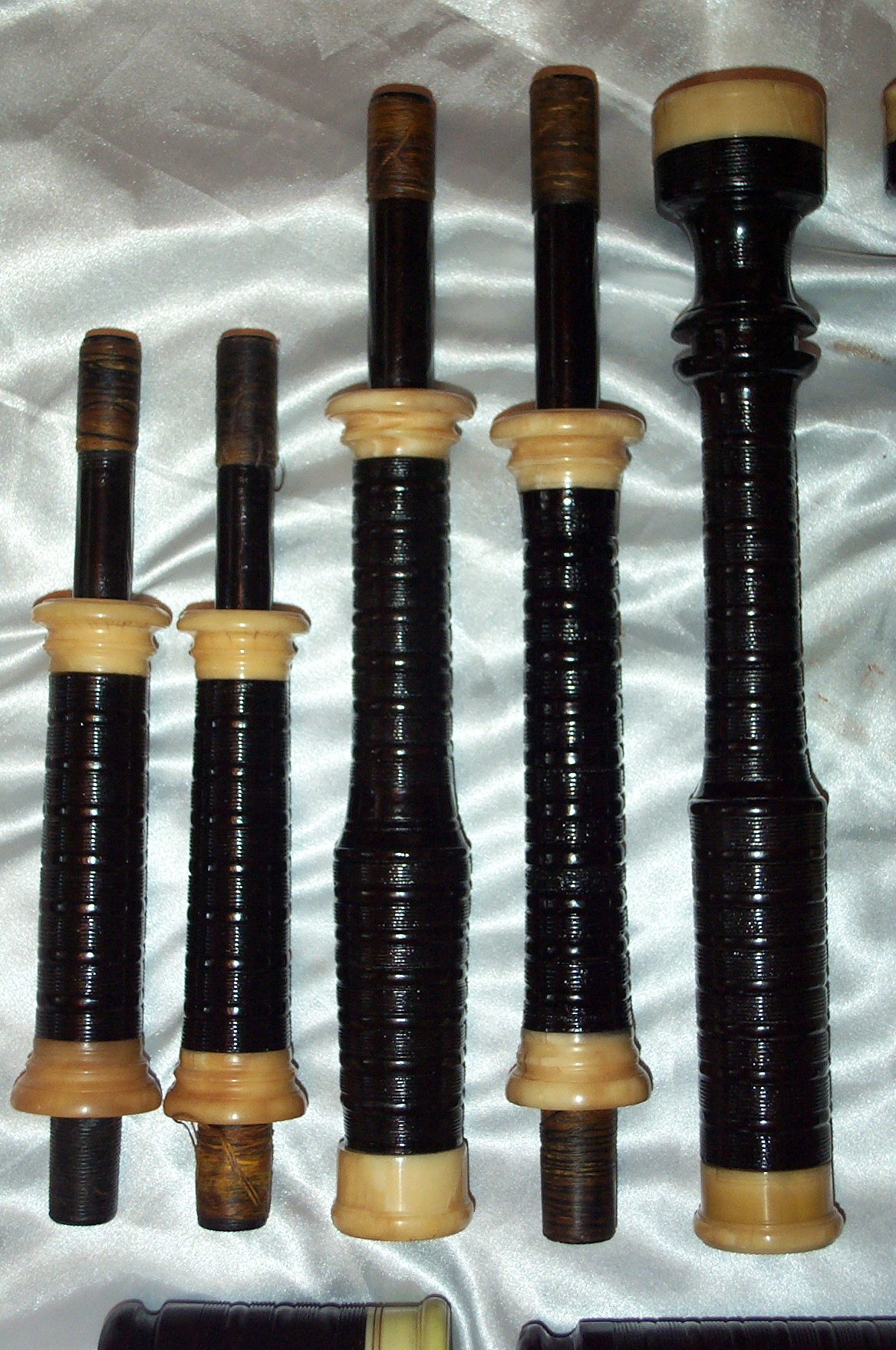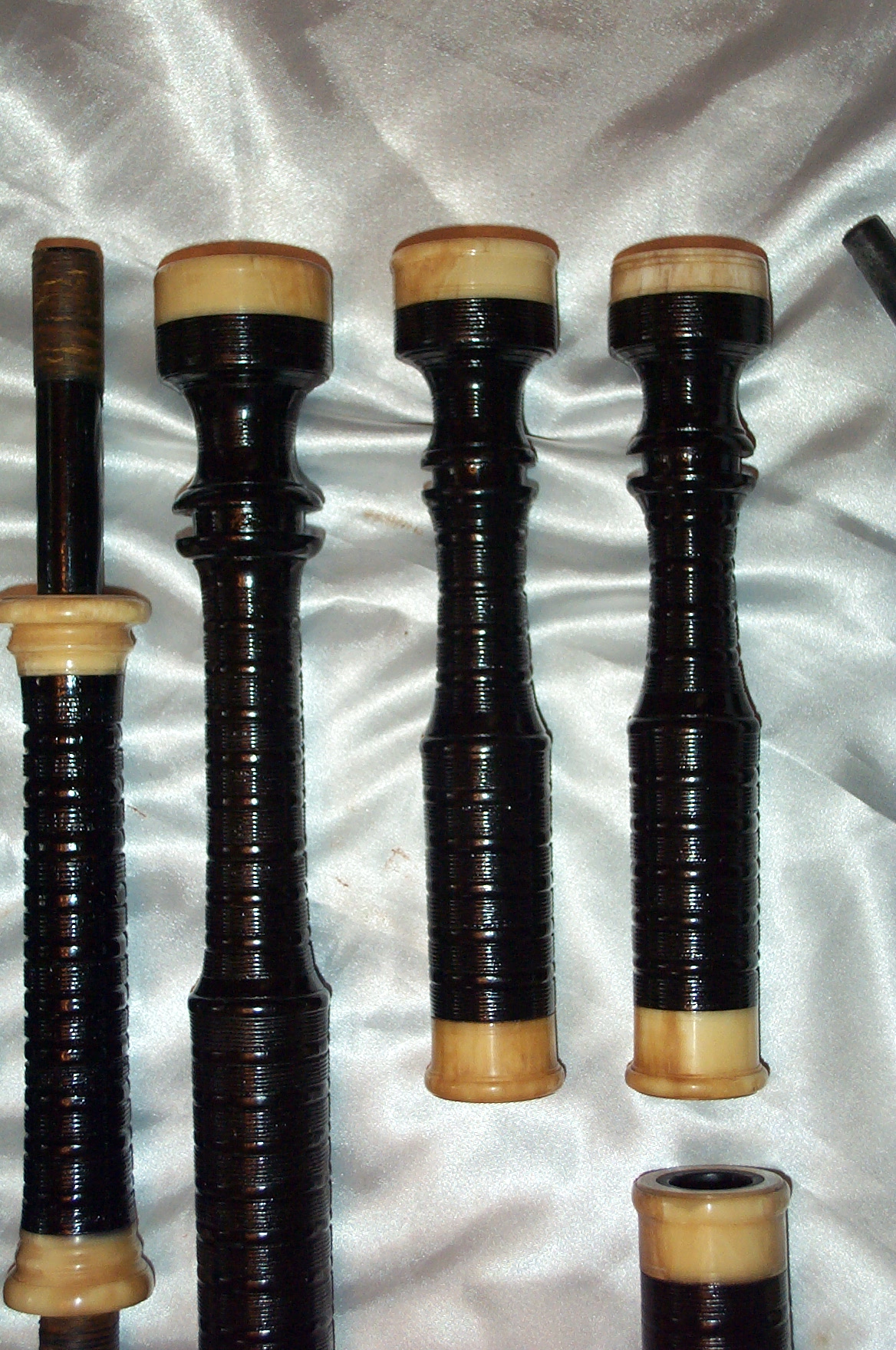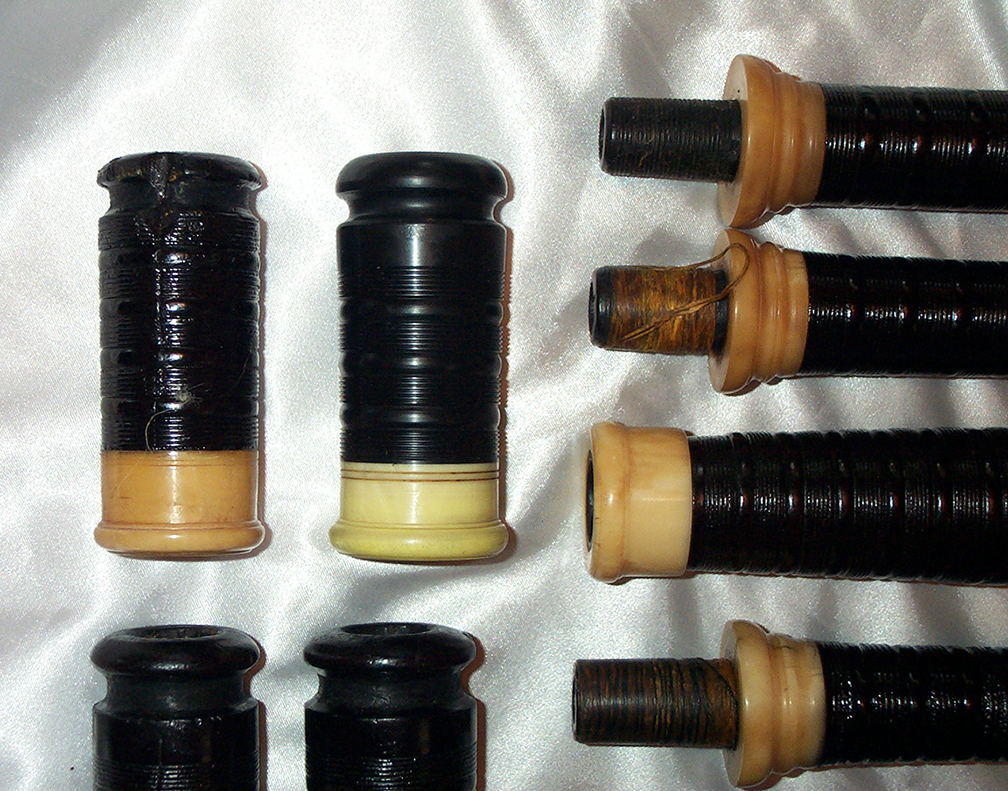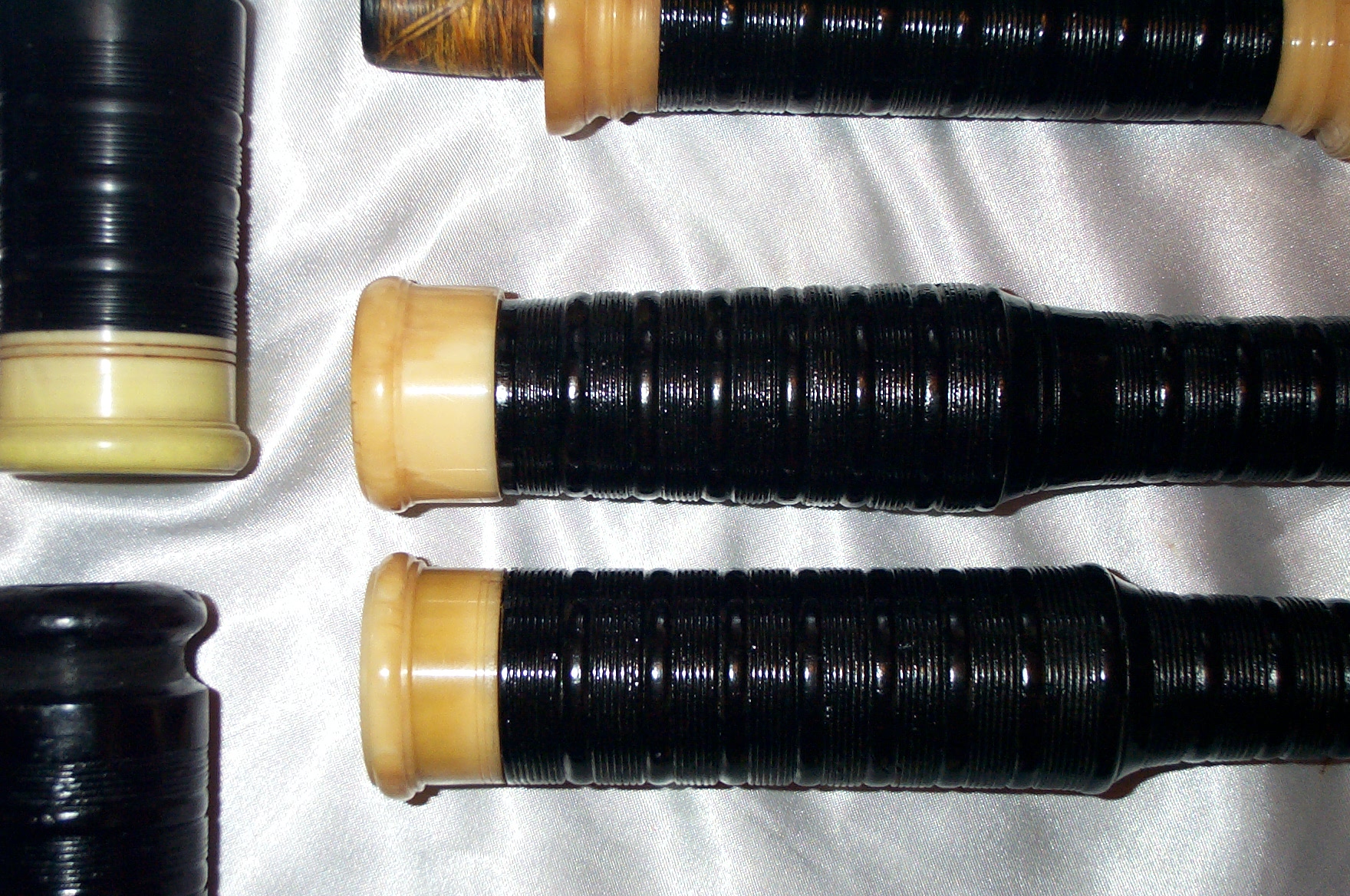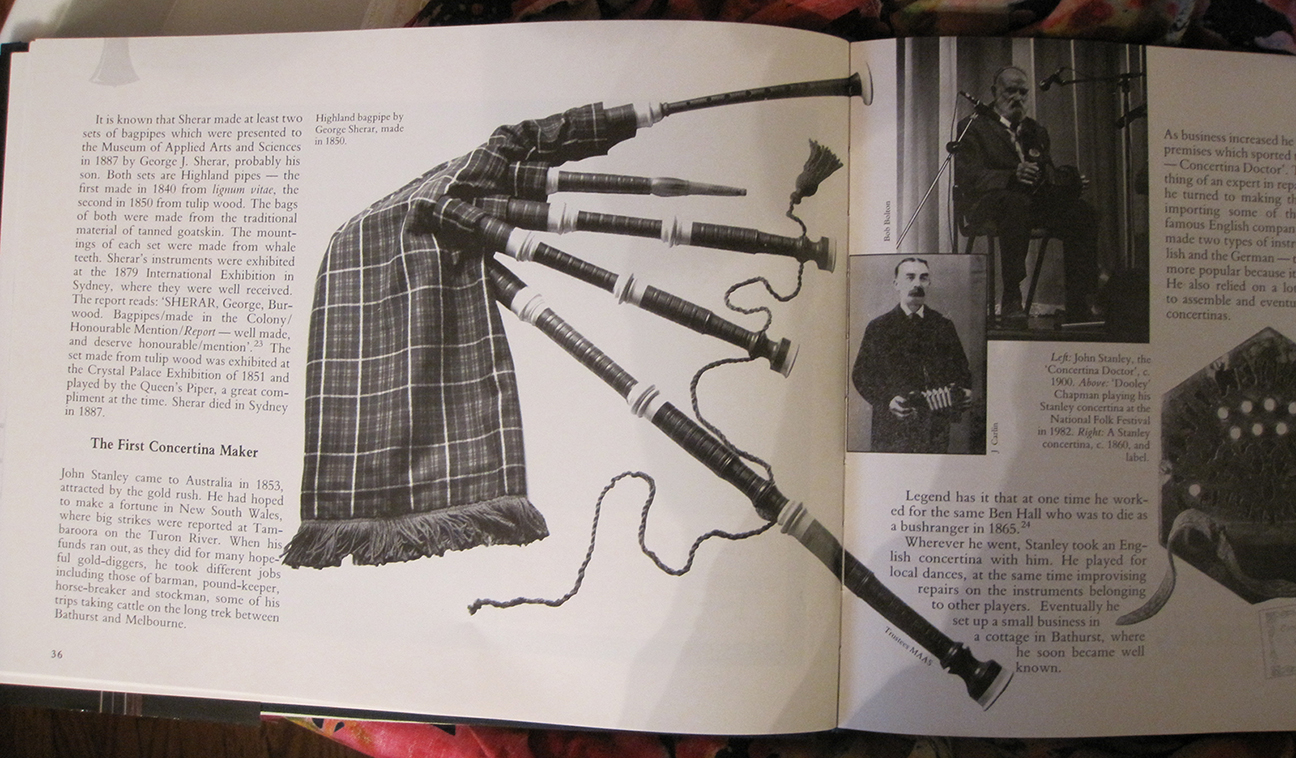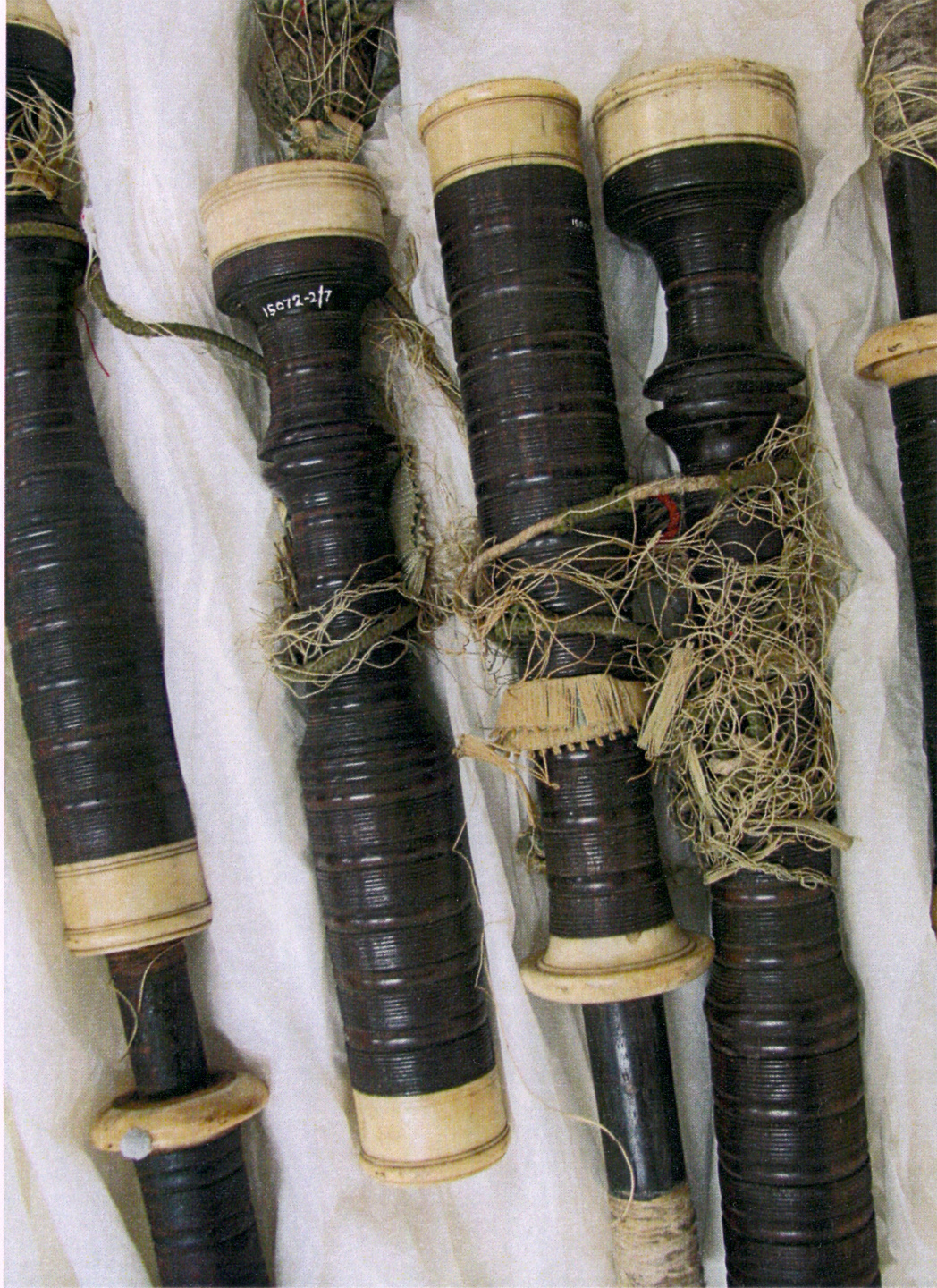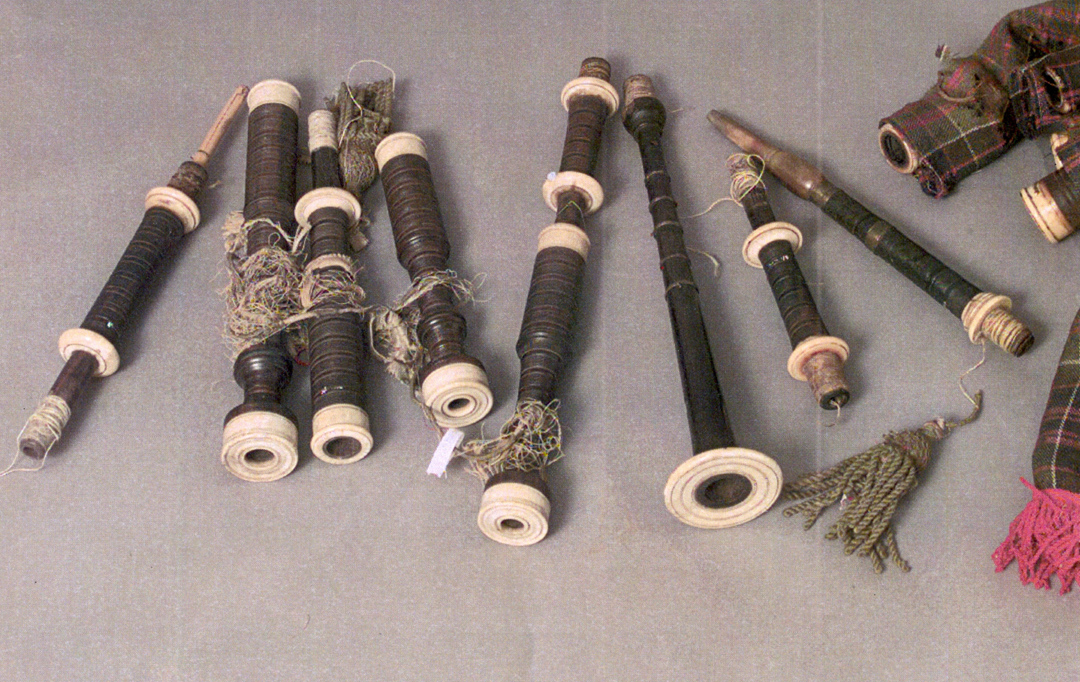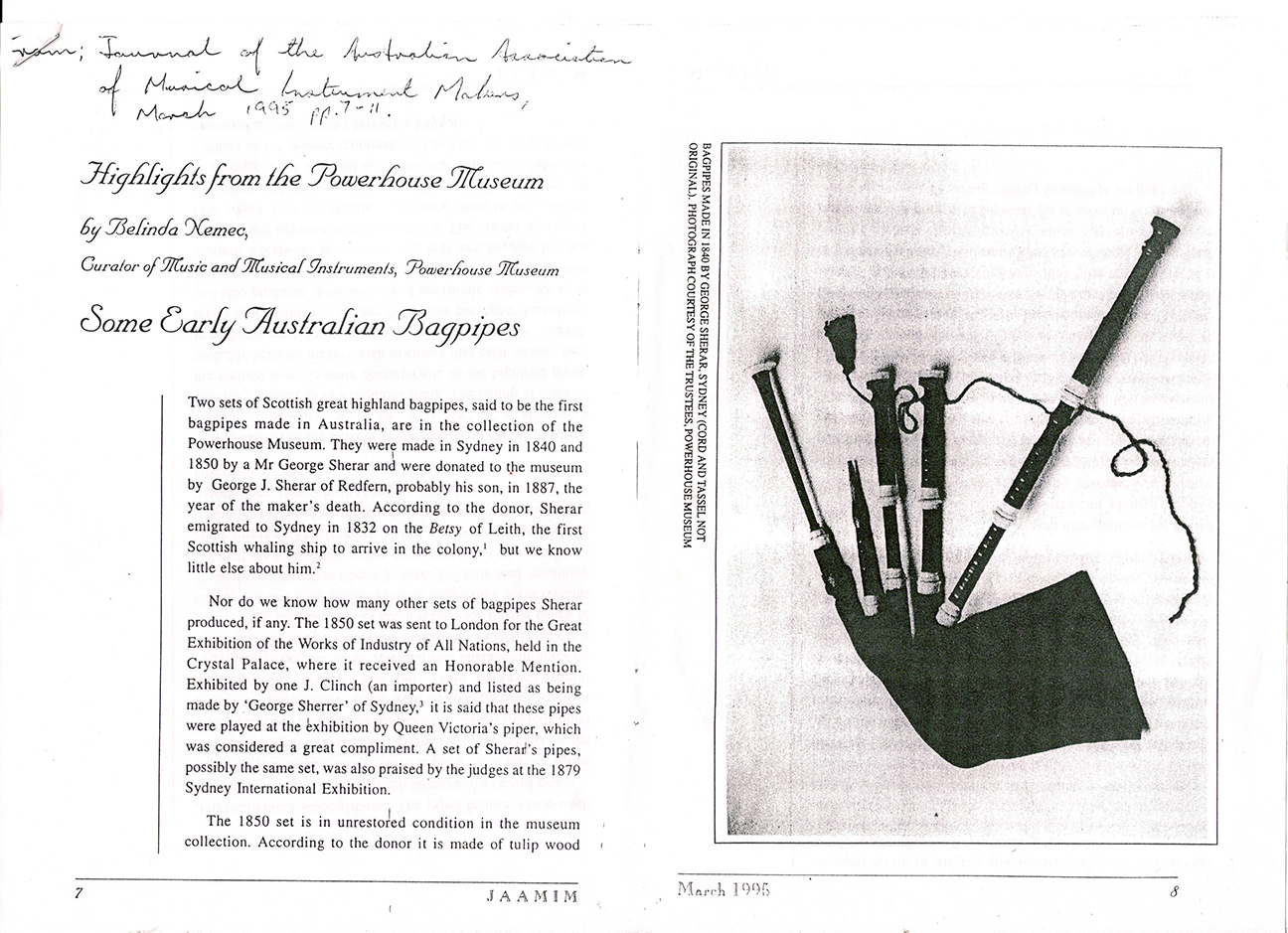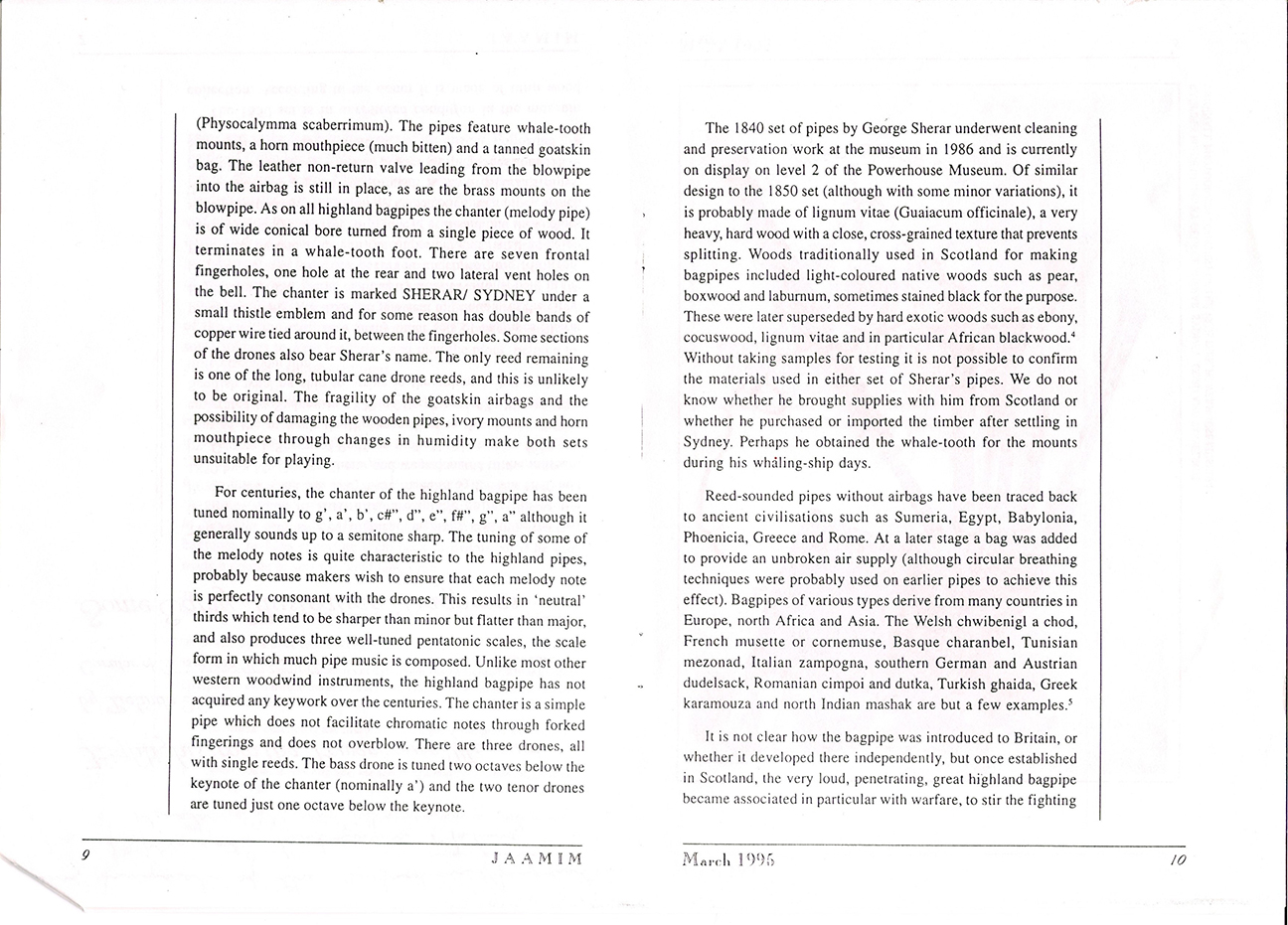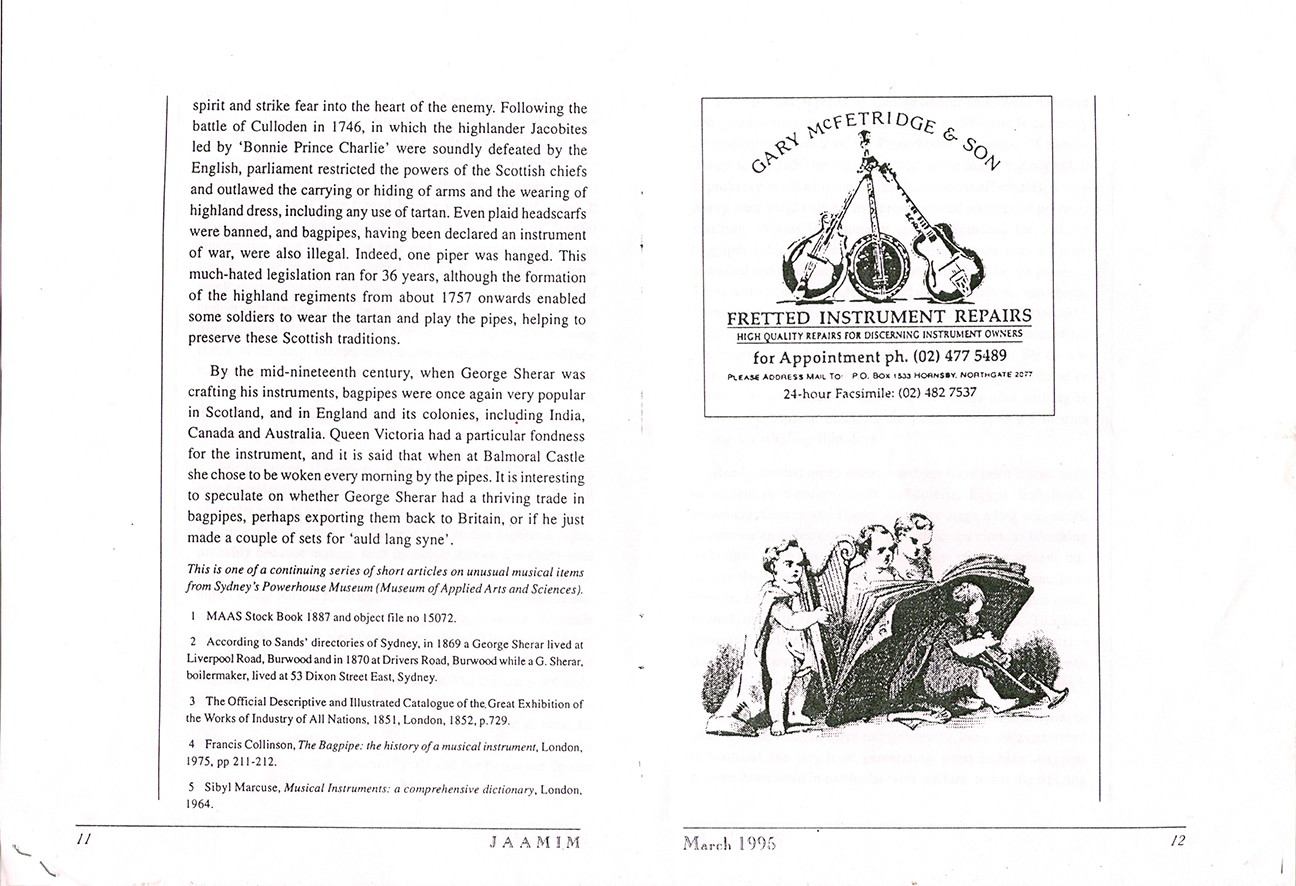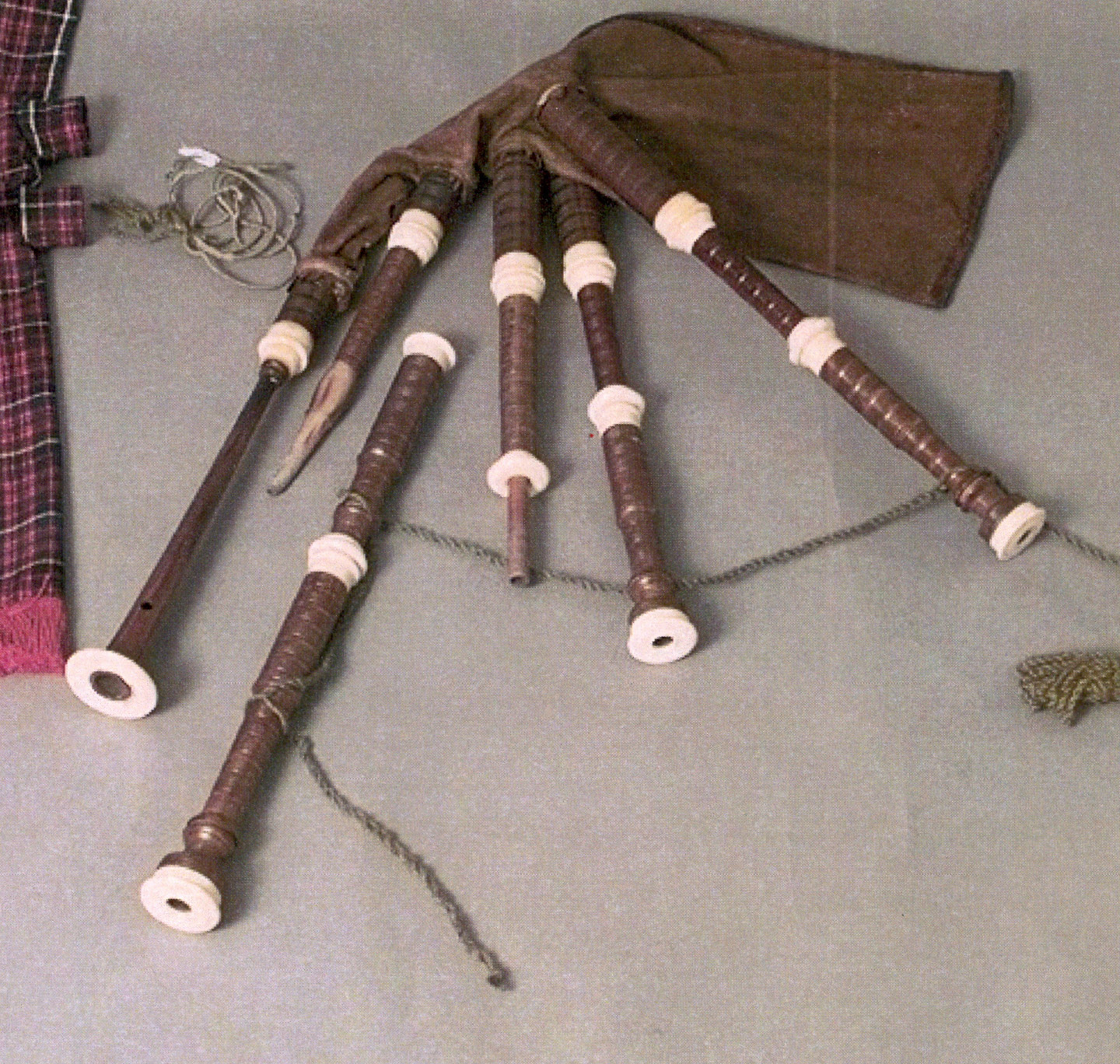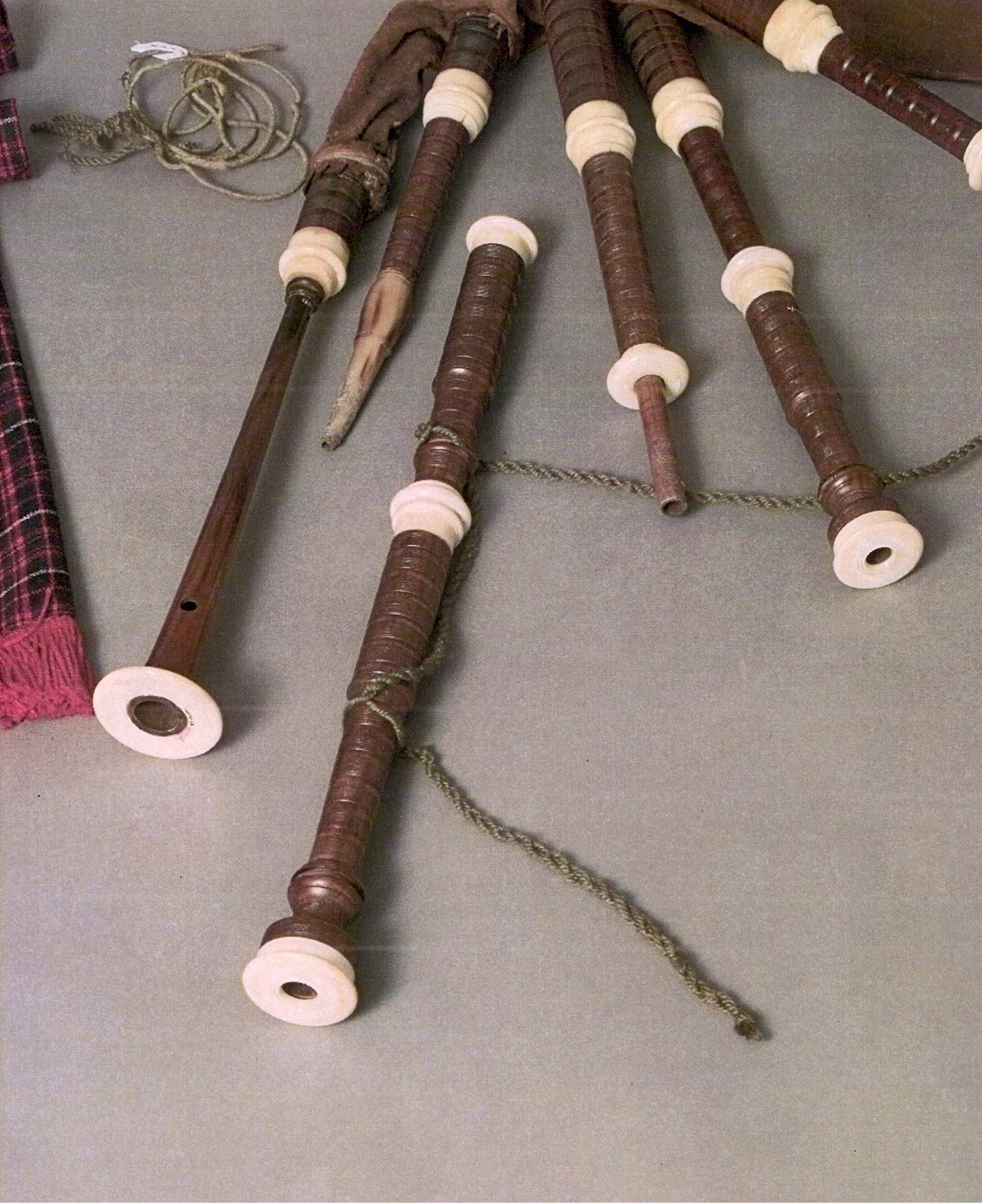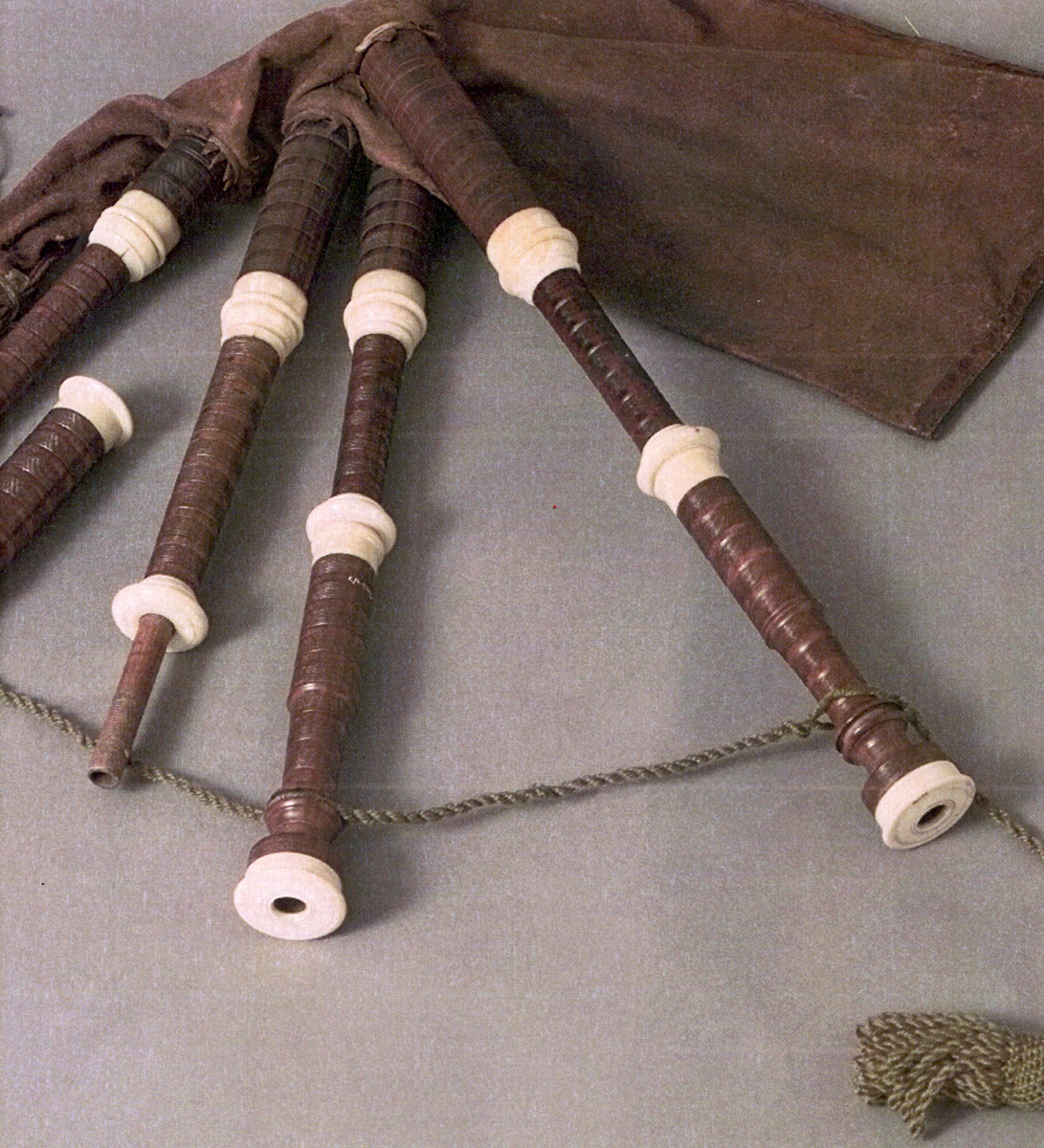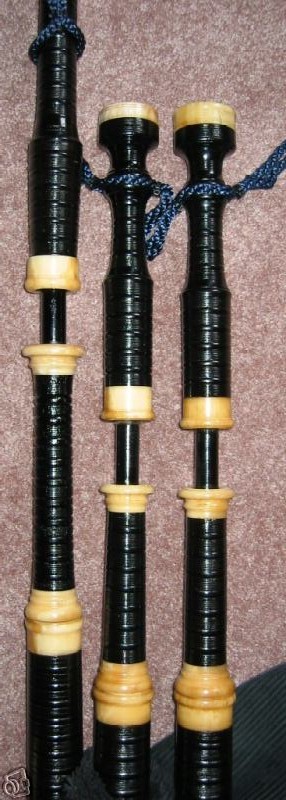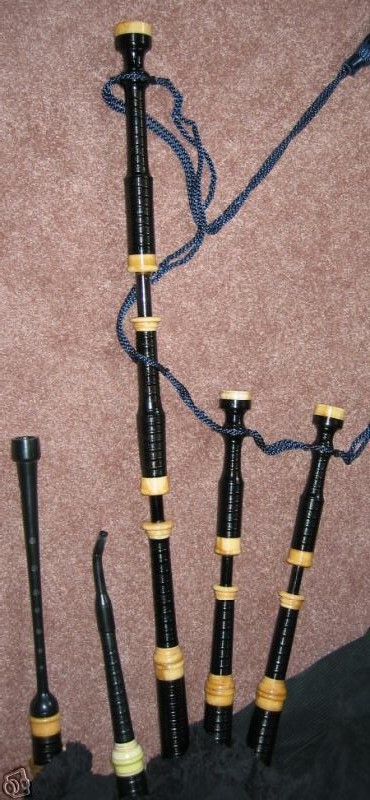This set of bagpipes was offered for sale in Australia as an "old Glen bagpipe". By the time they arrived in North America they were up on Ebay as "Donald MacDonald bagpipes". They were sent to a maker for restoration, who called me for an opinion. They were not a make that was known to me so I declined to speculate on who the maker might be and elected to originally put them up on the website as "unknown".
Sometime later I stumbled upong a book entitled "Instruments of Australia" and learned part of the story. Later, almost by accident, his great great great granddaughter contacted me. Years later another descendant also contacted me. I was provided with the following:
"George Sherar was born about 1814. His parents are listed as Francis Sherar, Wine & Spirit Dealer, Leith, Scotland. His mother was Jeanette Dingwall. I have not been able to locate their marriage certificate nor George's birth record. On his tombstone it states that George was native of Caithness.
In Oct 1828, George Sherar was indentured to the firm George Aitchison & Co and discharged in Leith on the 27th Oct 1832. We do not know much about this firm however believe George learnt his Block making and Shipbuilding skills here.
He arrived in Port Jackson, Sydney, NSW’s on the 30th May 1833 aboard The Betsy from Leith, Scotland. The Betsy was under the command of Captain Peter Petrie and was said to be the first Scottish Whaler to arrive in the colony. Shortly after arriving George Sherar married Eliza Barrett on the 25th November 1833 at the Scots church in Sydney. His marriage certificates states he was a Mariner.
Sometime later I stumbled upong a book entitled "Instruments of Australia" and learned part of the story. Later, almost by accident, his great great great granddaughter contacted me. Years later another descendant also contacted me. I was provided with the following:
"George Sherar was born about 1814. His parents are listed as Francis Sherar, Wine & Spirit Dealer, Leith, Scotland. His mother was Jeanette Dingwall. I have not been able to locate their marriage certificate nor George's birth record. On his tombstone it states that George was native of Caithness.
In Oct 1828, George Sherar was indentured to the firm George Aitchison & Co and discharged in Leith on the 27th Oct 1832. We do not know much about this firm however believe George learnt his Block making and Shipbuilding skills here.
He arrived in Port Jackson, Sydney, NSW’s on the 30th May 1833 aboard The Betsy from Leith, Scotland. The Betsy was under the command of Captain Peter Petrie and was said to be the first Scottish Whaler to arrive in the colony. Shortly after arriving George Sherar married Eliza Barrett on the 25th November 1833 at the Scots church in Sydney. His marriage certificates states he was a Mariner.
Along with the bagpipes, a certificate and Bronze medal were on display for some time at the technological museum in Sydney NSW’s Australia. The certificate and bronze medal were later returned to George John Sherar. Too this day we have not been able to locate the whereabouts of these items.
The fact that George Sherar made his first sets of bagpipes in 1840 & 1850 in Australia is of historical significance. They are not only among the earliest of musical instruments to have been made within the colony of Sydney, New South Wales but they are also one of the few surviving from those early days.
In a family Journal written by George William Sherar (son of George John Sherar) George Sherar Sr’s son had passed down from generation to generation a story regarding the Bagpipes, Geo William Wrote wrote:
“That George Sherar sr and his son George John Sherar (photo right) went over to the New Zealand during the Maori Wars, they went over in the gun boats, both taking their bagpipes with them and George Sherar taking his kilt. It is alleged this was reported to have caused some amusement. On one occasion he (??? unknown) in the friendly district marching as he played, came in touch with a Maori chief. The chief took him to the top of a hill and offered him all the land he could see if he would teach him to play the pipes, give him the kilt, bagpipes, and take one of his daughters as a wife. Of course this was declined.”
Within the Colony of Sydney George Sherar sr was often referred to as the highland piper and was well known for playing his pipes at celebrations and at will anywhere. This was not always appreciated as reported by one newspaper reported in December 1844 in which on one occasion George Sherar was playing his bagpipes at a public house, The Star and Garter Inn, where he struck up an offensive air playing the Boyne Water on his bagpipes. Nearby a soldier and his mates sat by. One was not amused whereby he picked up a brickbat and threw it at George, causing him to lose 2 teeth and lacerating his face.
George Sherar opened a Music shop, the Golden Grove Music Depot, in Driver’s Road, Burwood. Sometime later Driver’s Road was renamed Wentworth Road, Burwood. It was here I believe where George Sherar made and repaired highland bagpipes. While it is not known exactly when he opened up his shop and started bagpipe making business.
George Sherar died in tragic circumstances on the 4th May 1887 George Sherar was returning home to met his grandson at Eveleigh railway station after picking up Board & lodgings from his tenants. When George was alighting from the train at Eveleigh Railway station, the train still in motion he stepped of the train, slipped and fell beneath the train dying instantly. At that time his grandson George William Sherar, stood at the top of the stairs waiting for his grandfather unaware of what was happening below. After his death, his son, George John Sherar, took over the family business. The business later moved to 10 Ivy Street, Redfern. After George John Sherar death in 1900, his wife Mary Jane Sherar nee Brown ran the business until her death, about 1908. Thereafter the business was sold."
The fact that George Sherar made his first sets of bagpipes in 1840 & 1850 in Australia is of historical significance. They are not only among the earliest of musical instruments to have been made within the colony of Sydney, New South Wales but they are also one of the few surviving from those early days.
In a family Journal written by George William Sherar (son of George John Sherar) George Sherar Sr’s son had passed down from generation to generation a story regarding the Bagpipes, Geo William Wrote wrote:
“That George Sherar sr and his son George John Sherar (photo right) went over to the New Zealand during the Maori Wars, they went over in the gun boats, both taking their bagpipes with them and George Sherar taking his kilt. It is alleged this was reported to have caused some amusement. On one occasion he (??? unknown) in the friendly district marching as he played, came in touch with a Maori chief. The chief took him to the top of a hill and offered him all the land he could see if he would teach him to play the pipes, give him the kilt, bagpipes, and take one of his daughters as a wife. Of course this was declined.”
Within the Colony of Sydney George Sherar sr was often referred to as the highland piper and was well known for playing his pipes at celebrations and at will anywhere. This was not always appreciated as reported by one newspaper reported in December 1844 in which on one occasion George Sherar was playing his bagpipes at a public house, The Star and Garter Inn, where he struck up an offensive air playing the Boyne Water on his bagpipes. Nearby a soldier and his mates sat by. One was not amused whereby he picked up a brickbat and threw it at George, causing him to lose 2 teeth and lacerating his face.
George Sherar opened a Music shop, the Golden Grove Music Depot, in Driver’s Road, Burwood. Sometime later Driver’s Road was renamed Wentworth Road, Burwood. It was here I believe where George Sherar made and repaired highland bagpipes. While it is not known exactly when he opened up his shop and started bagpipe making business.
George Sherar died in tragic circumstances on the 4th May 1887 George Sherar was returning home to met his grandson at Eveleigh railway station after picking up Board & lodgings from his tenants. When George was alighting from the train at Eveleigh Railway station, the train still in motion he stepped of the train, slipped and fell beneath the train dying instantly. At that time his grandson George William Sherar, stood at the top of the stairs waiting for his grandfather unaware of what was happening below. After his death, his son, George John Sherar, took over the family business. The business later moved to 10 Ivy Street, Redfern. After George John Sherar death in 1900, his wife Mary Jane Sherar nee Brown ran the business until her death, about 1908. Thereafter the business was sold."
We are left with so many questions. Where did George learn to play and to make bagpipes? There were certainly excellent pipers and bagpipe makers in and around Leith during the early 19th century. It is not difficult to speculate however the facts may never be known. His design with the top bead on the ivory ring suggests very early Donald MacDonald however we certainly can't hold our thoughts there. The "reverse" ferrules are unique in my experience.
Tools and techniques used to make bagpipes were not common during those years, even in Scotland. It has been said that the pipers words guided the turners hands. Did Sherar have an instrument he used as a template or was he using blueprints made in Scotland. Or was he operating from memory or did he simply "originate" his instrument. We may never know.
The family continues to seek information concerning George. I would be happy to connect parties should someone have good information to share.
Tools and techniques used to make bagpipes were not common during those years, even in Scotland. It has been said that the pipers words guided the turners hands. Did Sherar have an instrument he used as a template or was he using blueprints made in Scotland. Or was he operating from memory or did he simply "originate" his instrument. We may never know.
The family continues to seek information concerning George. I would be happy to connect parties should someone have good information to share.
In 1840 & 1850 George Sherar made two sets of Highland bagpipes the first set was made of Lignum-Vitae mounted with whale teeth ivory. The second set was made of tulip wood mounted with whale teeth ivory. The pipe bags on both sets were made of tanned goat skin. Both sets of bagpipes were made within the Colony of Sydney NSW’s Australia. After the 1840 set was made, the Scottish chieftain who was in Sydney around 1841 wished to purchase them to take them to Scotland as the first bagpipes made in Australia. George declined the offer.
The 1850 set of bagpipes which were made of colonial material were sent to England to be exhibited at the crystal palace, Hyde Park, London at the great exhibition of the works of industry of all nations in 1851. George Sherar’s bagpipes were displayed and received an honorable mention. His bagpipes were played by the queen’s piper, William Ross, which was considered a great honor. The bagpipes were later returned to Australia with a bronze medal, certificate of Honorable mention and a copy of the Jurors report.
During the 1st highland gathering and highland brigade procession in Sydney, at the landing of HRH Duke of Edinburgh, Prince Alfred, both Sets of Bagpipes were played by George Sherar Sr and his Son George John Sherar for this occasion of the Royal tour in 1867.
According to a letter received by the museum from George John Sherar son of George Sherar Sr in 1887. His father made a wooden frame out of the same log the bagpipes were made out of in which to house his certificate.
The 1850 set of bagpipes which were made of colonial material were sent to England to be exhibited at the crystal palace, Hyde Park, London at the great exhibition of the works of industry of all nations in 1851. George Sherar’s bagpipes were displayed and received an honorable mention. His bagpipes were played by the queen’s piper, William Ross, which was considered a great honor. The bagpipes were later returned to Australia with a bronze medal, certificate of Honorable mention and a copy of the Jurors report.
During the 1st highland gathering and highland brigade procession in Sydney, at the landing of HRH Duke of Edinburgh, Prince Alfred, both Sets of Bagpipes were played by George Sherar Sr and his Son George John Sherar for this occasion of the Royal tour in 1867.
According to a letter received by the museum from George John Sherar son of George Sherar Sr in 1887. His father made a wooden frame out of the same log the bagpipes were made out of in which to house his certificate.
The bagpipe arrived to me in considerable distress. After carefully examining the pieces, my advice to the owner was to maintain the instrument as it was. I was not familiar with the wood but I did recognize the fixtures as marine ivory. (later identified as Tulip Wood and whale teeth) I hadn't a clue as to who made the instrument however I was able to confirm that it was neither Donald MacDonald nor any of the Glen's. I documented the instrument and placed the pictures in my "unknown" museum.
George Sherar and his bagpipes are historically significant. There are obvious ties to the makers in Edinburgh in the early part of the 1800's. Readers may draw their own conclusions.
George Sherar
Some long while later I happened upon a book entitled "Australian Made - Australian Played". My heart skipped a beat when I turned to page 36. There was the subject bagpipe and words regarding its maker. A few emails later and The Powerhouse Museum in Syndey was good enough to send me some pictures of their Sherer bagpipes on display.
